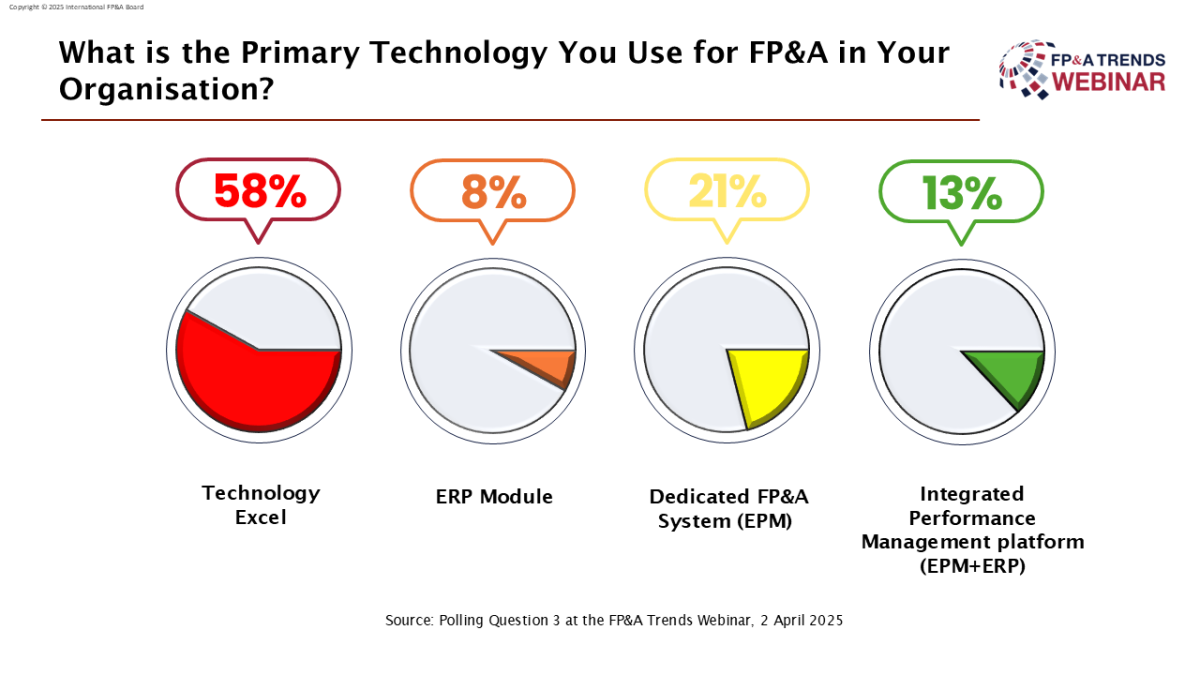Organisations that master Integrated FP&A can turn threats into competitive advantages, transforming disruptions into growth opportunities...
In today's volatile environment, 63% of organisations say they cannot forecast beyond a six-month horizon. It highlights the urgency for Financial Planning and Analysis (FP&A) teams to evolve from simply identifying trends to executing data-driven strategies that fuel performance and resilience.
The FP&A Trends Webinar, held on April 2nd, brought together industry leaders to unveil the top 5 FP&A trends for 2025. Through expert insights and practical perspectives, the session focused on transforming emerging trends into actionable strategies that elevate decision-making and operational outcomes.
The 5 Pillars of Future-Ready FP&A
A recent FP&A Trends white paper identifies five key trends that will define FP&A success in 2025 and beyond:
Transitioning from static annual planning to dynamic, real-time planning spanning functions, departments, and geographies.
2. Data-Driven Mastery
Unlocking the power of data to identify business drivers, sharpen forecasts, and support agile scenario planning.
3. Transformative Business Partnering
Leveraging technology to enable strategic collaboration between finance and the broader organisation, ensuring insights lead to measurable action.
4. AI Empowerment
Empowering teams with Artificial Intelligence and Machine Learning to boost productivity and enhance data-driven decision-making across all levels.
5. ESG Integration
Embedding sustainability and social impact into financial planning and strategic priorities — making ESG a core lens through which decisions are evaluated.

Figure 1
Agile FP&A in Action: PJT Partners' Strategic Vision for 2025
Joshua Baker, Senior Vice President at PJT Partners, opened the session by sharing how the firm is redefining FP&A through agility, innovation, and tight alignment with business operations.
FP&A as a Strategic Lever:
For PJT, FP&A is more than a support function — it's a strategic enabler. The firm's 2025 roadmap aligns with the five pillars of agile FP&A.

Figure 2
Key Transformation Areas:
- Operational Alignment: PJT is modernising its end-to-end expense processes to improve visibility, control, and efficiency in line with business functions.
- Data as a Competitive Advantage: Partnering with leadership, the FP&A team is building a disciplined framework to govern, produce, and leverage client data for differentiated insights.
- Business Enablement: Real-time scenario modelling, feedback tools, and performance tracking enable better decisions across business units.
- AI Adoption: The firm is evaluating AI to enhance core tools (Excel, PowerPoint), partner with best-in-class vendors, and develop custom AI agents that streamline planning and analytics.
- Sustainability and Inclusion: Diversity and ESG principles are deeply embedded in PJT's planning culture to enhance long-term value and innovation.
Early Results:
Just one quarter into 2025, PJT has seen:
- Enhanced data accuracy in forecasts
- Faster, deeper management reporting
- Improved cost accountability and control
- Progress in integrating compensation and equity planning with master data tools
Baker concluded with optimism: "We've done a lot, and we've deployed a lot. Now it's about going even deeper — whether it's in data, tools, or AI— to keep delivering value across the firm."
Poll Insight #1: Levels of FP&A Integration
A live poll during the session revealed that:
- 47% of organisations have achieved integration between finance and operations
- 13% between finance and strategy
- 16% reported full integration
- Only 24% said their planning is not integrated
These results suggest that most organisations are progressing toward unified planning. Josh Baker reflected on PJT's journey, emphasising that starting with finance-operations integration is a logical first step — and a trend increasingly observed across industries.

Figure 3
Harnessing Technology and AI to Empower FP&A: Anaplan's Perspective
In the second keynote, Iver van der Zand, VP of Product Management at Anaplan, explored how technology and AI revolutionise FP&A.
Emerging Market Trends:
- Connected Planning: Organisations seek to unify financial, demand, workforce, and capacity planning. However, many current systems remain siloed, limiting agility and responsiveness.
- Accelerated Deployment: Budget constraints and the need for speed are driving demand for out-of-the-box planning applications that deliver quick, tailored value.
- Unified Platforms: CFOs increasingly demand all-in-one solutions that integrate planning, actuals, and forecasting in a single environment.
Data as the Foundation:
Iver emphasised that 60% of the time in planning projects is spent preparing data — connecting, transforming, and loading it. Improving data orchestration and enabling seamless integration with data lakes has become a top priority.
AI in Planning:
AI is playing a dual role:
- As a natural language interface that simplifies scenario exploration
- As a workflow accelerator that automates model building and analysis
Additionally, the ability to ingest external data — like weather or event forecasts — into planning applications boosts accuracy and responsiveness.

Figure 4
Broader Industry Shifts:
Planning is becoming democratised, reaching beyond large enterprises to smaller businesses. The shift is toward real-time, continuous planning powered by workflow automation and user-friendly, self-service tools with embedded business logic.
Poll Insight #2: FP&A Technology in Use
The second poll revealed the current technology landscape in FP&A:

Figure 5
While Excel remains dominant due to its flexibility, the discussion highlighted its limitations in governance, scalability, and data integration. The trend toward more sophisticated systems indicates a growing recognition of the need for connected, enterprise-grade planning tools.
Conclusions: Data First, Always
The session closed with both speakers' powerful, shared message: data is the cornerstone of successful FP&A.
- Josh Baker emphasised that integrating live orchestrated data is critical to enabling AI, analytics, and advanced forecasting capabilities.
- Iver van der Zand echoed this sentiment, advocating for a "data-first" mindset. He noted that the primary challenge is not the technology but the effort required to manage and prepare data effectively.
Together, they underscored that mastering data orchestration and connectivity would define the next era of FP&A — one where agility, scalability, and insight are not aspirational but operational realities.
Special Thanks
We extend our gratitude to Anaplan, our technology sponsor, and our panellists for their invaluable contributions and thought leadership.
Subscribe to
FP&A Trends Digest

We will regularly update you on the latest trends and developments in FP&A. Take the opportunity to have articles written by finance thought leaders delivered directly to your inbox; watch compelling webinars; connect with like-minded professionals; and become a part of our global community.






